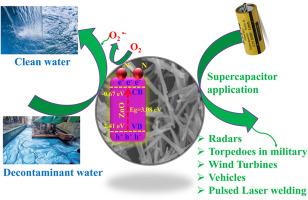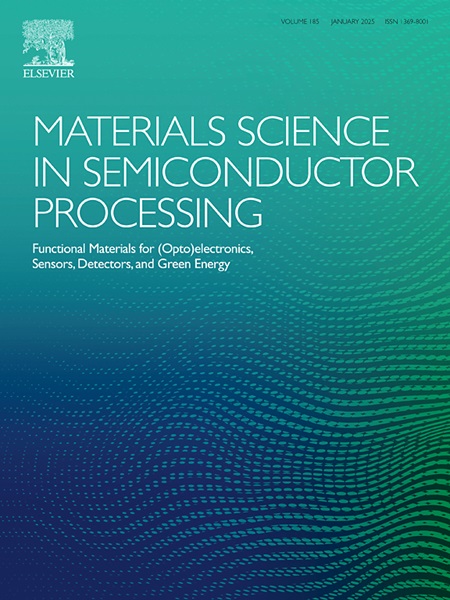Fabrication of N-doped ZnO for evaluation of photocatalytic degradation of methylene blue, methyl orange and improved supercapacitor efficiency under redox-active electrolyte
IF 4.2
3区 工程技术
Q2 ENGINEERING, ELECTRICAL & ELECTRONIC
引用次数: 0
Abstract
The fabrication of an N-doped ZnO nanocomposite was described in this study using hydrothermal methods at various temperatures (200–600 °C). The developed N-doped ZnO nanocomposite was also utilized to investigate supercapacitors and photocatalytic degradation of pigments. Improving ZnO supercapacitor and photocatalytic dye decomposition capabilities proved quite difficult. Consequently, it was essential to create an N-doped ZnO at various temperatures. This approach aims to improve photocatalytic dye degradation and energy storage in N-doped ZnO nanocomposites in a synergistic manner. As we evaluated the photocatalytic activity, the N-doped ZnO-600 °C nanocomposite showed better methylene blue (MB) and methyl orange (MO) degradation efficiency. In just 120 min of exposure to visible light, about 99 % and 99.1 % of the MB and MO deterioration was seen; in contrast, only 60.5 %, 70.2 %, 79.6 %, 84 %, and 99 % of the MB degradation and 57.7, 62, 61.6, 70.1, 76.9, 84.2, and 99.1 % was shown on the pure ZnO, TiO2 (P25), ZnO-200 °C, ZnO-400 °C, ZnO-600 °C, and N-ZnO 600 °C materials, respectively. The increased photocatalytic efficiency was ascribed to the synergistic effect, improved charge separation, and increased visible light absorption by the N-ZnO 600 °C nanocomposite. Using XRD, UV–vis DRS, PL, FE-SEM, and HR-TEM investigations, the structural, optical, and surface morphology of the produced catalyst were examined. Additionally, the produced material was used in potassium hydroxide (KOH) and redox additive electrolytes (RE) electrochemical supercapacitor performance. Comprehensive studies revealed that the N-ZnO electrode enhanced cycle voltammetry (CV), galvanostatic charge-discharge (GCD), rate ability, and reliability under redox additive electrolytes (RE) and potassium hydroxide (KOH). The inclusion of RE increased the efficiency even more, indicating the potential for advanced applications of energy storage. The highest specific capacitance of the ZnO electrode increased significantly from 159 Fg-1 in KOH to 498 Fg-1 at 1 Ag-1. The N-ZnO-600 °C electrode, on the other hand, demonstrated a maximum specific capacitance of 288 Fg-1 at 1 Ag-1 in KOH and a significantly higher specific capacitance of 762 Fg-1 at 1 Ag-1 in KOH + RE.

制备掺杂 N 的氧化锌,用于评估亚甲基蓝和甲基橙的光催化降解以及在氧化还原活性电解质条件下提高超级电容器的效率
本研究采用水热法在不同温度(200-600 °C)下制备了掺杂 N 的氧化锌纳米复合材料。所开发的掺杂 N 的氧化锌纳米复合材料还被用于研究超级电容器和颜料的光催化降解。事实证明,提高氧化锌超级电容器和光催化染料分解能力相当困难。因此,必须在不同温度下制造出掺杂 N 的氧化锌。这种方法旨在以协同增效的方式提高掺杂 N 的氧化锌纳米复合材料的光催化染料降解和能量存储能力。在光催化活性评估中,掺杂 N 的 ZnO-600 ℃ 纳米复合材料显示出更好的亚甲基蓝(MB)和甲基橙(MO)降解效率。在短短 120 分钟的可见光照射下,亚甲基蓝和甲基橙的降解率分别为 99% 和 99.1%;相比之下,亚甲基蓝的降解率分别为 60.5%、70.2%、79.6%、84% 和 99%,甲基橙的降解率分别为 57.7%、62.6%、61.6% 和 99%。纯 ZnO、TiO2 (P25)、ZnO-200 ℃、ZnO-400 ℃、ZnO-600 ℃ 和 N-ZnO 600 ℃ 材料的降解率分别为 57%、62%、61.6%、70.1%、76.9%、84.2% 和 99.1%。光催化效率的提高归因于 N-ZnO 600 °C 纳米复合材料的协同效应、电荷分离的改善以及可见光吸收的增加。利用 XRD、UV-vis DRS、PL、FE-SEM 和 HR-TEM 研究了所制备催化剂的结构、光学和表面形态。此外,还将制得的材料用于氢氧化钾(KOH)和氧化还原添加剂电解质(RE)的电化学超级电容器性能。综合研究表明,在氧化还原添加剂电解质(RE)和氢氧化钾(KOH)中,N-氧化锌电极增强了循环伏安法(CV)、电静态充放电法(GCD)、速率能力和可靠性。加入 RE 后,效率进一步提高,这表明了先进储能应用的潜力。氧化锌电极的最高比电容从 KOH 中的 159 Fg-1 显著增加到 1 Ag-1 时的 498 Fg-1。另一方面,N-ZnO-600 °C 电极在 KOH 溶液中 1 Ag-1 时的最大比电容为 288 Fg-1,在 KOH + RE 溶液中 1 Ag-1 时的比电容为 762 Fg-1。
本文章由计算机程序翻译,如有差异,请以英文原文为准。
求助全文
约1分钟内获得全文
求助全文
来源期刊

Materials Science in Semiconductor Processing
工程技术-材料科学:综合
CiteScore
8.00
自引率
4.90%
发文量
780
审稿时长
42 days
期刊介绍:
Materials Science in Semiconductor Processing provides a unique forum for the discussion of novel processing, applications and theoretical studies of functional materials and devices for (opto)electronics, sensors, detectors, biotechnology and green energy.
Each issue will aim to provide a snapshot of current insights, new achievements, breakthroughs and future trends in such diverse fields as microelectronics, energy conversion and storage, communications, biotechnology, (photo)catalysis, nano- and thin-film technology, hybrid and composite materials, chemical processing, vapor-phase deposition, device fabrication, and modelling, which are the backbone of advanced semiconductor processing and applications.
Coverage will include: advanced lithography for submicron devices; etching and related topics; ion implantation; damage evolution and related issues; plasma and thermal CVD; rapid thermal processing; advanced metallization and interconnect schemes; thin dielectric layers, oxidation; sol-gel processing; chemical bath and (electro)chemical deposition; compound semiconductor processing; new non-oxide materials and their applications; (macro)molecular and hybrid materials; molecular dynamics, ab-initio methods, Monte Carlo, etc.; new materials and processes for discrete and integrated circuits; magnetic materials and spintronics; heterostructures and quantum devices; engineering of the electrical and optical properties of semiconductors; crystal growth mechanisms; reliability, defect density, intrinsic impurities and defects.
 求助内容:
求助内容: 应助结果提醒方式:
应助结果提醒方式:


